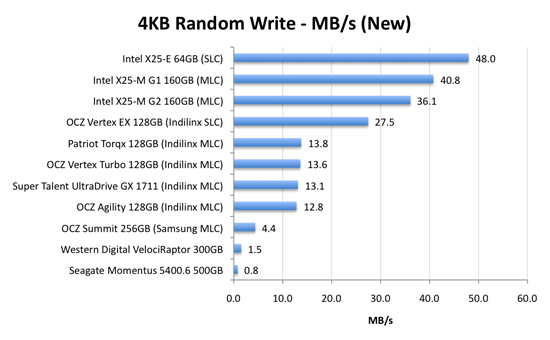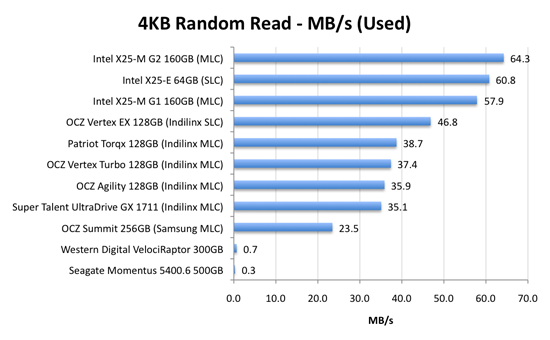The SSD Relapse: Understanding and Choosing the Best SSD
by Anand Lal Shimpi on August 30, 2009 12:00 AM EST- Posted in
- Storage
Random Read/Write Speed
This test writes 4KB in a completely random pattern over an 8GB space of the drive to simulate the sort of random writes that you'd see on an OS drive (even this is more stressful than a normal desktop user would see). I perform three concurrent IOs and run the test for 3 minutes. The results reported are in average MB/s over the entire time:

As we established in previous articles, the disk operations that feel the slowest are the random small file reads and writes. Both of which are easily handled by an SSD. A good friend of mine and former AnandTech Editor, Matthew Witheiler, asked me if he'd notice the performance improvement. I showed him the chart above.
He asked again if he'd notice. I said, emphatically, yes.

Now this is super interesting. Intel's X25-M G1 drops from 40.8MB/s when new down to 26.3MB/s in a well used state. Unfortunately for the G1, it will never get TRIM and will spend more time in the lower performance state over the life of the drive. But look at what happens with the X25-M G2: it drops from 36.1MB/s to 35.8MB/s - virtually no performance is lost. In fact, the G2 is so fast here that it outperforms the super expensive X25-E. Granted you don't get the lifespan of the X25-E and the SLC drive should perform better on more strenuous random write tests, but this is a major improvement.
The explanation? It actually boils down to the amount of memory on the drive. The X25-M G1 had 16MB of 166MHz SDRAM on-board, the G2 upped it to 32MB of slower 133MHz DRAM. Remember that Intel doesn't keep any user data in DRAM, it's only used for the remapping, defragmenting and tracking of all of the data being written to the drive. More DRAM means that the drive can now track more data, which means that even in the heaviest of random-write workloads you could toss at it on a normal desktop you will not actually lose any performance with the drive in a used state. And this is the drive Intel has decided to grant TRIM to.
The G2 is good.
The Indilinx drives do lose performance here. They drop from roughly 13MB/s down to 7MB/s. We're still talking ~5x the speed of a VelociRaptor, so there's no cause for alarm. But it's clear that even Indilinx's SLC drive can't match Intel's random write performance. And from what I hear, Intel's performance is only going to get better.
This is what the X25-M price premium gets you.

Bahahaha, look at the hard drive scores here: 0.7MB/s and 0.3MB/s? That's freakin' terrible! And that's why your system feels so slow when you start it up, there are a ton of concurrent random reads and writes happening all over the place which your hard drive crunches through at roughly 0.5MB/s. Even the Samsung based OCZ Summit manages a significant performance advantage here.
The Indilinx drives all cluster around the 30 - 40MB/s mark for random read performance, nothing to be ashamed of. The Intel drives kick it up a notch and give you roughly 60MB/s of random read performance. It's a noticeable improvement. As our application launch tests will show however, loading a single app on either an Indilinx or Intel drive will take about the same amount of time. It's only in the heavy multitasking and "seat of the pants" feel that you'll have a chance at feeling a difference.










295 Comments
View All Comments
sotoa - Friday, September 4, 2009 - link
Another great article. You making me drool over these SSD's!I can't wait till Win7 comes to my door so I can finally get an SSD for my laptop.
Hopefully prices will drop some more by then and Trim firmware will be available.
lordmetroid - Thursday, September 3, 2009 - link
I use them both because they are damn good and explanatory suffixes. It is 2009, soon 2010 I think we can at least get the suffixes correct, if someone doesn't know what they mean, wikipedia has answers.AnnonymousCoward - Saturday, September 5, 2009 - link
As someone who's particular about using SI and being correct, I think it's better to stick to GB for the sake of simplicity and consistency. The tiny inaccuracy is almost always irrelevant, and as long as all storage products advertise in GB, it wouldn't make sense to speak in terms of GiB.Touche - Thursday, September 3, 2009 - link
Both articles emphasize Intel's performance lead, but, looking at real world tests, the difference between it and Vertex is really small. Not hardly enough to justify the price difference. I feel like the articles are giving an impression that Intel is in a league of its own when in fact it's only marginally faster.smjohns - Tuesday, September 8, 2009 - link
This is where I struggle. It is all very well quoting lots of stats about all these drives but what I really want to know is if I went for Intel over the OCZ Vertex (non-turbo) where would I really notice the difference in performance on a laptop?Would it be slower start up / shut down?
Slower application response times?
Speed at opening large zipped files?
Copying / processing large video files?
If the difference is that slim then I guess it is down to just a personal preference....
morrie - Thursday, September 3, 2009 - link
I've made it a habit of securely deleting files by using "shred" like this: shred -fuvz, and accepting the default number of passes, 25. Looks like this security practice is now out, as the "wear" on the drive would be at least 25x faster, bringing the stated life cycles closer to having an impact on drive longevity. So what's the alternative solution for securely deleting a file? Got to "delete" and forget about security? Or "shred" with a lower number of passes, say 7 or 10, and be sure to purchase a non-Intel drive with the ten year warranty and hope that the company is still in business, and in the hard drive business, should you need warranty service in the outer years...Rasterman - Wednesday, September 16, 2009 - link
watching too much CSI, there is an article somewhere i read by a data repair tech who works in one of the multi-million dollar data recovery labs, basically he said writing over it once is all you should do and even that is overkill 99% of the time. theoretically it is possible to even recover that _sometimes_, but the expense required is so high that unless you are committing a billion dollar fraud or are the secretary to osama bin laden no one will ever try to recover such data. chances are if you are in such circles you can afford a new drive 25x more often. and if you have such information or knowledge wouldn't be far easier and cheaper to simply beat it out of you than trying to recover a deleted drive?iamezza - Friday, September 4, 2009 - link
1 pass should be sufficient for most purposes. Unless you happen to be working on some _extremely_ sensitive/important data.derkurt - Thursday, September 3, 2009 - link
I may be wrong on this, but I'd assume that once TRIM is enabled, a file is securely deleted if it has been deleted on the filesystem level. However, it might depend on the firmware when exactly the drive is going to actually delete the flash blocks which are marked as deletable by TRIM. For performance reasons the drive should do that as soon as possible after a TRIM command, but also preferably at a time when there is not much "action" going on - after all, the whole point of TRIM is to change the time of block erasing flash cells to a point where the drive is idle.
morrie - Thursday, September 3, 2009 - link
That's on a Linux system btwAs to aligning drives...how about an update to the article on what needs to be done/ensured, if anything, for using the drives with a Linux OS?